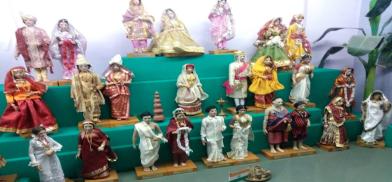Dolls as conduits of cultural expression: India’s autumn festivals and their enchanting celebration through dolls
In India, festivals have an interesting blend of representation through dolls, especially during the agricultural season of autumn, writes Dr. Lopamudra Maitra Bajpai for South Asia Monitor

Dolls often represent an important segment of personal narratives. They are not only a key part of visual and material culture but signify a significant aspect of the intangible cultural heritage of a region or a locality, including being integral parts of festivals and celebrations. This is not particular to India alone. Countries across the globe have dolls in major festivals.
In India, festivals have an interesting blend of representation through dolls, especially during the agricultural season of autumn, spread across September through November.
Navratri forms a special part with doll decorations across the southern states. In Tamil Nadu, Andhra Pradesh, Telengana, Karnataka and Kerala, Navratri is celebrated with dolls, variously referred to as Kolu or Bommai Kolu, Gombe Habba or Bommala Koluvu. In Tamil, Bommai Kolu means Divine Presence. In Telugu, Bommala Koluvu stands for Court of Toys and in Kannada Bombe Habba denotes Doll Festival. Organized by women and girls, this is an occasion to visit other houses to see doll decorations.
During Navratri, these dolls are an occasion to worship the Tri Devi - Parvati, Saraswati and Lakshmi. Made traditionally from clay or wood in Tanjore, Madurai or in villages in Andhra or West Bengal, often new dolls are added every year. Several dolls form part of the family heirloom and are passed on from generation to generation. Faded ones are repaired and broken ones replaced. This helps local artists.
Dolls tell stories
The dolls are generally kept on three to nine ‘padi’ - Tamil word for tiers. Each tier represents specific socio-cultural concepts. For a nine-tier display, the first three tiers are for gods and goddesses while tiers four through six are the ones where kings, queens, demi-gods and saints are kept. The seventh tier displays traditions and celebrations, the eights aspects of common life and the final tier has dolls symbolizing living creatures. At various instances, there are different themes, including the Ramayana, Mahabharata, local history or modern themes with an essence of environmental consciousness, like saving Mother Earth, conservation of trees and water, and curbing air pollution,
The storytelling associated with the dolls is interesting. They are associated with the victory of Goddess Durga over demon king Mahish through her reincarnated form of Mahishashurmardini. According to a legend, the doll festival began from the heydays of the Vijayanagar kingdom. Another legend traces the beginning to the splendorous times of the Mysore royal family. Interesting parallels are drawn between gopurams (ornate pyramidal tower at a temple entrace) of temples and the golu display (festival display of dolls and figurines). Just like the gopurams the golu displays are tiered in odd numbers and their size corresponds to the size of the room and house. In gopurams too, the size is relative to the size of its village, town or city.
Shivaji made popular
Following closely the Navratri festival of dolls is the decoration of Diwali Killa (Diwali Fort) or Shivaji Killa from Maharashtra and northern Karnataka with clay figurines of Chhatrapati Shivaji Maharaj, his ministers and peasants. The fort and the hill are built in the days preceding Diwali with stones, bricks, jute sacks, clay, hay, leaves, branches and mud. The base of the hill is made to resemble a village region with farmlands, rivers, canals, peasants, animals and birds. The fort atop the hill has a clay figurine of Shivaji on a throne, surrounded by ministers and soldiers. Some represent historical characters like Tanhaji.
On Diwali day, the fort and the entire decoration is lit up. The celebration ends with firecrackers. The brightly coloured dolls resemble myriad notes from everyday lives. There are dolls resembling common people, bullock carts, even animals and birds. Kumbhars or potters from various places get busy preparing these clay figurines in the Kumbharwada region of Pune.
The storytelling marking these decorations reminds the importance of the history of forts and the contributions of Shivaji, including creating a sense of peaceful life for the masses. The preparation of the Diwali Killa involves participation of both the young and the old of a family, bringing local history closer to the younger generation.
While the same region witnesses cow worship at Diwali, in Goa Gorvancho Padwo marks the creation of a small model cowshed made from cow dung. Traditionally, this is built below the Tulsi Vrindavan of a household. Inside the cowshed, a tiny model of cows are made from wild fruit caarit and a doll is placed, symbolising a ‘gavli’ or a cowherd.
Lord Krishna regales
Sometimes, a figurine representing Lord Krishna is kept alongside. The storytelling associated with the creation pays homage to the hardworking cows, who are given a day’s rest. It is also an occasion to echo the mythological stories of Lord Krishna’s association with cows and his slaying of the demon Narakasura.
Storytelling is witnessed through Govardhan Puja during Deepavali. Observed a day after Badi Diwali or the day of Lakshmi Puja, it is celebrated across several regions of northern, western and central India. It reflects the mythological story of Lord Krishna lifting the Govardhan mountain to save the villagers from heavy rains and floods, triggered by Lord Indra. This story is brought alive through building a small mound, representing the Govardhan hill, with several small figurines which stand for Krishna and villagers. The mountain is built with cow dung, mud and clay. The ritual use of cow dung symbolizes a celebration of the annual crop cycle.
Stories are a part of everyday lives. A visual representation helps to identify narratives as conduits for exploring the world around us, especially connecting to young minds. Dolls remain an inseparable part of these conduits of expression.
(The author is a visual anthropologist and author. The views expressed are personal. She can be reached on lopamudramaitra@gmail.com)










Post a Comment